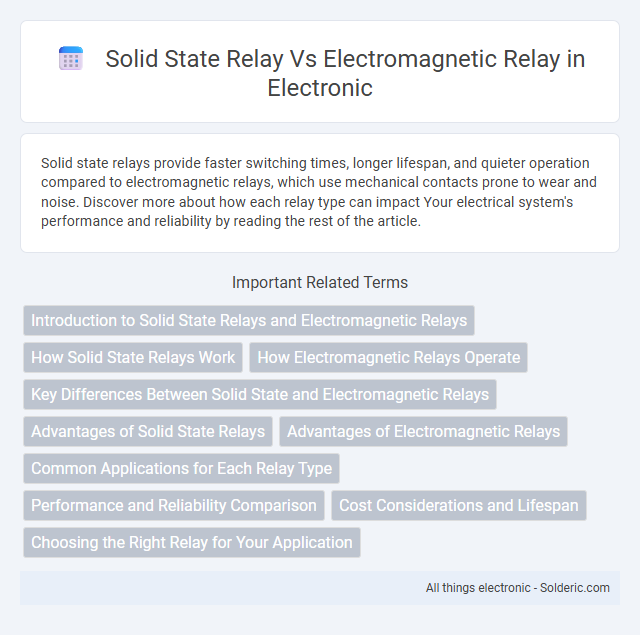Solid state relays provide faster switching times, longer lifespan, and quieter operation compared to electromagnetic relays, which use mechanical contacts prone to wear and noise. Discover more about how each relay type can impact Your electrical system's performance and reliability by reading the rest of the article.
Comparison Table
| Feature | Solid State Relay (SSR) | Electromagnetic Relay (EMR) |
|---|---|---|
| Switching Mechanism | Semiconductor-based (no moving parts) | Mechanical contacts |
| Response Time | Microseconds | 10-20 milliseconds |
| Durability | High, no mechanical wear | Lower, contact degradation over time |
| Noise | Silent operation | Audible click |
| Voltage Isolation | Optical isolation | Magnetic isolation |
| Load Capacity | Lower surge current handling | Higher surge current handling |
| Power Dissipation | Higher heat generation, requires heat sink | Minimal heat loss |
| Cost | Generally higher | Generally lower |
| Applications | Fast switching, silent operation, long life (industrial, automation) | General-purpose, cost-sensitive, high surge loads |
Introduction to Solid State Relays and Electromagnetic Relays
Solid State Relays (SSRs) use semiconductor components to switch electrical loads without moving parts, offering silent operation and faster switching speeds compared to Electromagnetic Relays (EMRs), which rely on physical contacts and magnetic coils. SSRs provide enhanced durability and are ideal for applications requiring high-speed or frequent switching, while EMRs are generally preferred for their cost-effectiveness and ability to handle high inrush currents. Understanding the differences between your relay options can help optimize performance and reliability in your electrical control systems.
How Solid State Relays Work
Solid State Relays (SSRs) operate by using semiconductor components such as thyristors, triacs, or transistors to switch electrical loads without moving parts, providing faster and quieter operation compared to electromagnetic relays. When a small input voltage is applied to the SSR's control circuit, it triggers the semiconductor device to conduct current and energize the load, enabling precise and reliable switching. Your choice of SSR can improve durability and reduce electrical noise in applications requiring frequent or high-speed switching.
How Electromagnetic Relays Operate
Electromagnetic relays operate by using an electromagnet to mechanically switch contacts, allowing current to flow through a circuit when energized. When voltage is applied to the coil, it generates a magnetic field that attracts a movable armature, closing or opening the relay contacts to control the load. This mechanical movement provides electrical isolation and reliable switching for various industrial and electronic applications.
Key Differences Between Solid State and Electromagnetic Relays
Solid state relays (SSRs) use semiconductor components to switch circuits without moving parts, offering faster response times and longer operational life compared to electromagnetic relays (EMRs), which rely on mechanical contacts and coils. SSRs provide silent operation and are more resistant to shock and vibration, making them ideal for applications requiring high reliability and minimal maintenance, whereas EMRs are better suited for environments where cost and simplicity are primary concerns. Understanding these key differences allows you to select the appropriate relay type based on switching speed, durability, noise level, and application-specific requirements.
Advantages of Solid State Relays
Solid state relays (SSRs) offer significant advantages over electromagnetic relays, including faster switching speeds and longer operational lifespans due to the absence of moving parts. They provide silent operation and enhanced resistance to shock and vibration, making them ideal for sensitive or high-reliability applications. Your system benefits from lower maintenance requirements and improved performance in high-frequency switching scenarios with SSRs.
Advantages of Electromagnetic Relays
Electromagnetic relays offer reliable electrical isolation between control and load circuits, ensuring safe operation in high-voltage environments. They provide cost-effective switching for a wide range of currents and voltages, suitable for industrial applications requiring mechanical feedback. Their robust design allows operation under extreme temperatures and electrical surges, making them ideal for harsh environments.
Common Applications for Each Relay Type
Solid state relays (SSRs) are commonly used in industrial automation, HVAC systems, and precision temperature control due to their fast switching speeds and silent operation. Electromagnetic relays excel in applications requiring high current switching, such as motor control, power distribution, and automotive systems, where mechanical robustness is essential. Your choice depends on factors like load type, switching speed, and environmental conditions.
Performance and Reliability Comparison
Solid state relays (SSRs) outperform electromagnetic relays (EMRs) in switching speed, with SSRs capable of microsecond response times compared to EMRs' milliseconds. SSRs offer higher reliability due to lack of moving parts, reducing mechanical wear and extending operational lifespan often exceeding 10 million cycles. EMRs, however, provide better performance under high surge currents and are less sensitive to voltage spikes, but their mechanical components increase failure risk in demanding environments.
Cost Considerations and Lifespan
Solid state relays generally have a higher initial cost compared to electromagnetic relays due to their advanced semiconductor components but offer a longer lifespan with no mechanical parts to wear out. Electromagnetic relays are more affordable upfront but tend to have a shorter operational life because their mechanical contacts degrade over time. Your choice should factor in long-term reliability and maintenance expenses as solid state relays reduce downtime with extended durability.
Choosing the Right Relay for Your Application
When choosing the right relay for your application, consider the switching speed and durability requirements; solid state relays (SSRs) offer faster switching times and longer operational lifespans due to lack of moving parts compared to electromagnetic relays (EMRs). SSRs provide silent operation and better resistance to shock and vibration, making them ideal for high-frequency switching and harsh environments, whereas EMRs are cost-effective and suitable for applications requiring high current capacity with slower switching. Evaluate factors such as load type, switching frequency, electrical isolation, and budget constraints to select between SSRs and EMRs for optimal performance and reliability.
solid state relay vs electromagnetic relay Infographic

 solderic.com
solderic.com